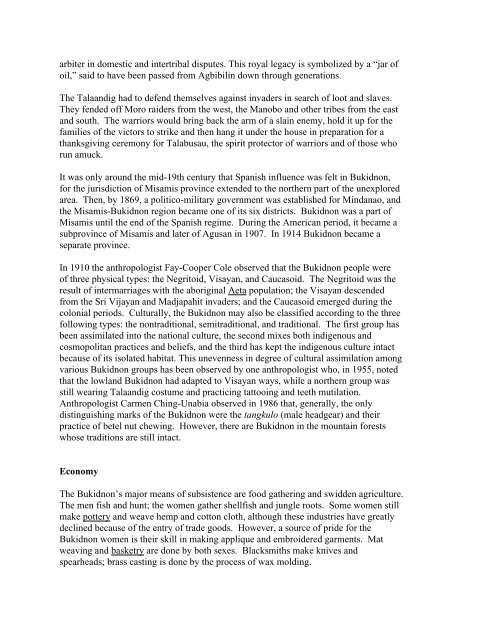You also want an ePaper? Increase the reach of your titles
YUMPU automatically turns print PDFs into web optimized ePapers that Google loves.
arbiter in domestic and intertribal disputes. This royal legacy is symbolized by a “jar of<br />
oil,” said to have been passed from Agbibilin down through generations.<br />
The Talaandig had to defend themselves against invaders in search of loot and slaves.<br />
They fended off Moro raiders from the west, the Manobo and other tribes from the east<br />
and south. The warriors would bring back the arm of a slain enemy, hold it up for the<br />
families of the victors to strike and then hang it under the house in preparation for a<br />
thanksgiving ceremony for Talabusau, the spirit protector of warriors and of those who<br />
run amuck.<br />
It was only around the mid-19th century that Spanish influence was felt in <strong>Bukidnon</strong>,<br />
for the jurisdiction of Misamis province extended to the northern part of the unexplored<br />
area. Then, by 1869, a politico-military government was established for Mindanao, and<br />
the Misamis-<strong>Bukidnon</strong> region became one of its six districts. <strong>Bukidnon</strong> was a part of<br />
Misamis until the end of the Spanish regime. During the American period, it became a<br />
subprovince of Misamis and later of Agusan in 1907. In 1914 <strong>Bukidnon</strong> became a<br />
separate province.<br />
In 1910 the anthropologist Fay-Cooper Cole observed that the <strong>Bukidnon</strong> people were<br />
of three physical types: the Negritoid, Visayan, and Caucasoid. The Negritoid was the<br />
result of intermarriages with the aboriginal Aeta population; the Visayan descended<br />
from the Sri Vijayan and Madjapahit invaders; and the Caucasoid emerged during the<br />
colonial periods. Culturally, the <strong>Bukidnon</strong> may also be classified according to the three<br />
following types: the nontraditional, semitraditional, and traditional. The first group has<br />
been assimilated into the national culture, the second mixes both indigenous and<br />
cosmopolitan practices and beliefs, and the third has kept the indigenous culture intact<br />
because of its isolated habitat. This unevenness in degree of cultural assimilation among<br />
various <strong>Bukidnon</strong> groups has been observed by one anthropologist who, in 1955, noted<br />
that the lowland <strong>Bukidnon</strong> had adapted to Visayan ways, while a northern group was<br />
still wearing Talaandig costume and practicing tattooing and teeth mutilation.<br />
Anthropologist Carmen Ching-Unabia observed in 1986 that, generally, the only<br />
distinguishing marks of the <strong>Bukidnon</strong> were the tangkulo (male headgear) and their<br />
practice of betel nut chewing. However, there are <strong>Bukidnon</strong> in the mountain forests<br />
whose traditions are still intact.<br />
Economy<br />
The <strong>Bukidnon</strong>’s major means of subsistence are food gathering and swidden agriculture.<br />
The men fish and hunt; the women gather shellfish and jungle roots. Some women still<br />
make pottery and weave hemp and cotton cloth, although these industries have greatly<br />
declined because of the entry of trade goods. However, a source of pride for the<br />
<strong>Bukidnon</strong> women is their skill in making applique and embroidered garments. Mat<br />
weaving and basketry are done by both sexes. Blacksmiths make knives and<br />
spearheads; brass casting is done by the process of wax molding.
















